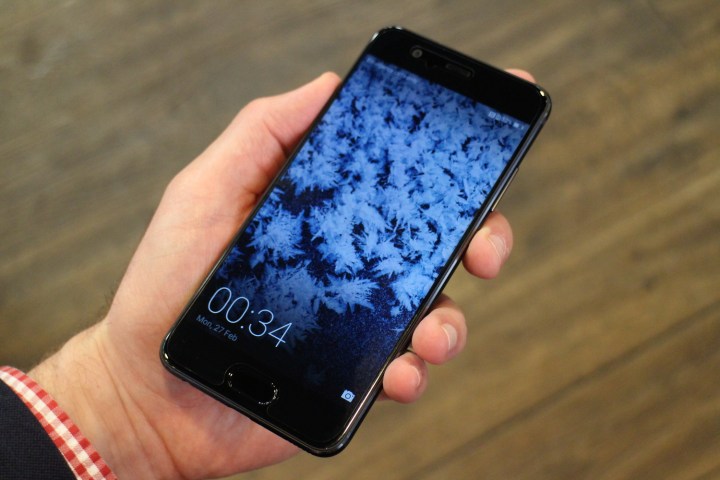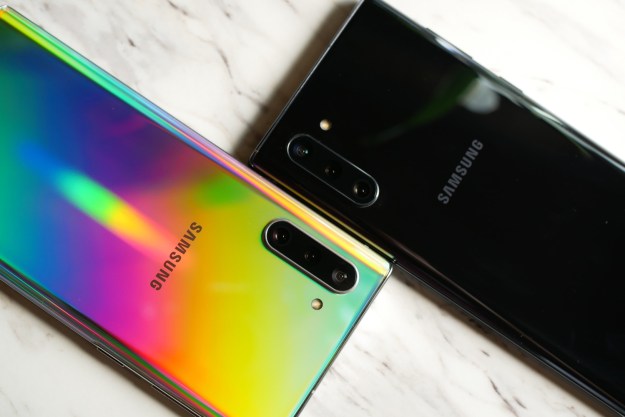The Huawei P10 turns everything up to the max with a better design, camera, and performance.
Huawei has made clear advances with its P-series range of smartphones over the past couple of years: the P8 struck a good balance between style and functionality, which then went into overdrive with the P9. The partnership with Leica gave the P9 a desirability that wasn’t always present before, and the camera remains one of the best out there. It has since been surpassed by the excellent Mate 9, which comes with an even better version of the Leica cam, but with a more restrained visual style.
Now we’ve got the P10, which brings the second-generation Leica camera from the Mate 9, adds some very welcome new features and tweaks, then puts it inside a package that’s far easier to handle, and vastly better looking. That’s a delectable mix, and gives the P10 a gargantuan task — it needs to live up to expectations based on our love of the Mate 9 and the P9. We had some hands-on time with the phone to see if it can reach them.
A gorgeous design with fun colors
Huawei says the P10 is for trendsetters, extroverts, and the artistic. Much of this is reflected in the camera, but it’s also evident in the design of the phone. It’s a beauty, but extroverts — and lovers of awesome looking phones in general — will have to pick the right color for the P10 to really standout. There’s actually only one choice for this: Huawei’s dazzling blue. It makes the most of the new “hyper diamond cut” technique that gives the metal rear a textured, reflective surface that looks super. Get it in the right light, and it reacts in an expected way, alternately taking on a concave or convex look. It’s an optical illusion, but it really catches the eye.
The fingerprint sensor reacts to gestures.
There are eight colors in the P10 range, and Huawei has worked with color experts Pantone to create the dazzling blue, and one called greenery, which is 2017’s color of the year. It’s not quite so successful, and is going to be a love-or-hate choice, we think. The P10 is very compact — it has a 5.1-inch, 1,920 x 1,080-pixel screen — and the sides are flatter than many other modern phones, providing a little more grip. Note also that the camera lenses are flush to the body, resulting in a clean and minimalist look.
More Leica camera greatness
The dual Leica camera lenses and sensors on the P10 are the same second-generation versions used on the Mate 9. That means a 12-megapixel color sensor, and a 20-megapixel monochrome sensor, with a f/2.2 aperture and optical image stabilization on the color cam. For the P9, Huawei emphasized its ability to shoot amazing landscapes and urban environments, but for the P10, it has switched attention to pictures of people. There’s a new button alongside the bokeh control, which Huawei calls Portrait mode, and it specifically targets faces in your photos.
An advanced facial recognition mode maps 190 points in 3D space, tracking faces even as they move around, to automatically adjust the lighting in your photo based on the scene, skin tone, and other conditions. A reactive beauty mode further enhances the picture. We tried it out, mainly on group shots, and found the auto lighting system to be very effective. It genuinely enhanced faces in a dully lit room, but the bokeh effect which blurs the background wasn’t quite as good. It had some trouble isolating a focal point in crowded scenes, making group photos look a little confused. However, the software on the phone we tried wasn’t final, and we definitely need to test it more.
There’s excellent news for monochrome fans, as the bokeh mode has been added to the second lens, too. A feature missing from both the P9 and the Mate 9, it’s one Leica devotees will welcome, thanks to the many of the brand’s most famous pictures shot in monochrome with background shots. They can now be mimicked using the P10. Even just messing around with it in a simple meeting room produced some startling shots. We can’t wait to see what it can do in the real world. Another first is Leica’s involvement in the selfie camera, which has a Leica sensor with double the brightness and a wider dynamic range. It also auto-adjusts the frame depending on how many people are in the picture.
EMUI 5.1 and Android 7.0
Dig into the software, and Huawei has been leveraging its growing machine learning ability in the gallery app. Pictures are tagged and classified during the phone’s downtime (at night, for example), then arranged into albums based on an event, a person, or other group. A video montage is generated for you, which can be edited through an app co-developed with GoPro. It brings the easy and comprehensive editing features from its own Quik app to the P10. It looks great, and the app’s editing features are genuinely simple to understand.
Staying with the software, the P10 has Android 7.0 Nougat with EMUI 5.1 over the top. This is a slightly updated version of EMUI 5.0 on the Mate 9, which transformed the old, annoying way a Huawei phone operated into something way more coherent, intuitive, and enjoyable. Things are much the same in 5.1, but with a few new features. The first is a worry, because it edges away from the more familiar, native Android experience brought in with EMUI 5.0, and back in a custom direction.
On the P10, the fingerprint sensor reacts to gestures. A tap acts as the back button, a swipe to the left opens the recently used app menu, and a long press takes you back home. It’s very reminiscent of Meizu’s Flyme user interface, which employs the same type of system, and the same things apply to both. Android’s menu buttons aren’t pretty, but we all know how they work, and they do the job perfectly well. It’s change for change’s sake.
Bokeh mode has been added to the second lens.
Thankfully, like the option to activate the app drawer or have all your apps on the home screen, you can turn it off and just have the Android buttons as usual. There are potentially more helpful enhancements deep inside EMUI, which affect how memory is used in order to speed the phone up, resulting in apps that open 30 percent faster than before, plus clever predictive touchscreen technology that anticipates where your finger is going, and increasing responsiveness. Those are the sort of changes we want.
Huawei P10 Plus and more specs
Holding the P10 was a reminder of how good it is to use a phone with a screen around 5-inches in size. It’s just so manageable. However, Huawei knows other people want a larger display, so will also produce the 5.5-inch, 2,560 x 1,440 pixel, P10 Plus. Both phones have the Kirin 960 2.4GHz octa-core processor — the same chip that makes the Mate 9 such a strong performer — but the standard P10 has 4GB of RAM and 64GB of storage, while the P10 Plus has 6GB of RAM and 256GB internal storage space. It also gets a larger battery — 3,750mAh over the P10’s 3,200mAh, both of which support Huawei’s SuperCharge fast charging. The P10 Plus gains a “Pro” edition of the Leica camera, which adds different lenses to the same sensors as the P10, and a f/1.8 aperture for more natural bokeh shots.
Availability and pricing
The P10 will cost 650 euros and come to Europe, Asia, and other markets. The P10 Plus costs 700 euros. However, we do know neither will arrive in the United States. This is unfortunate, but it may not remain that way forever. Huawei launched the Mate 9 in the U.S. at CES this year, several months after it’s international debut, so there’s a vague chance it’ll do the same with the P10 in the future.
Huawei has done the right thing with the P10 by not drastically changing the new, winning formula found with the Mate 9 and the P9, just enhancing, tweaking and subtly improving. In other words, Huawei’s growing maturity as a leading smartphone manufacturer is showing in its phones.
Highs
- Beautiful, minimalist style
- Improved Leica camera
- Leica-developed selfie cam
- Strong specs
- Comfortable to hold
Lows
- Not all the software changes are for the best
- Unavailable in the U.S. for now
Editors' Recommendations
- Huawei’s Nova 10 smartphones offer a freakishly huge selfie camera
- Does the Huawei P50 Pro take better pics than the Pixel 6 Pro?
- Huawei P50 Pocket rivals Z Flip 3 in design, but not price
- OnePlus CEO takes on 10 Pro critics by releasing official photos
- Huawei’s P50 Pro launches with 200x camera zoom, but leaves out 5G











